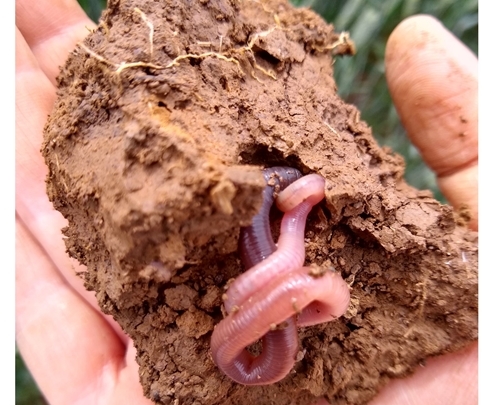Written by Dr Jenny Bussell, Soil Scientist at The Allerton Project

Earthworms hold a fascination in the global consciousness. Watching their slow wriggly progress across my saturated lawn, glistening patio, and squelchy flowerbeds has been a common pastime during the recent wet weather and it turns out I’m not alone. The Common Earthworm, Lumbricus terrestris, is the posterchild for UK earthworms due to its impressive size and longevity, living for an average of 4-8 years and growing up to an enormous 35cm when mature. It recently wiggled its way to a landslide victory in The Guardian’s inaugural invertebrate of the year award, cementing its place (for this year at least) as the UK’s favourite spineless creature. However, in the spirit in which the competition was launched, I’m here to champion not just the Common Earthworm, but also the whole underrated family of Earthworms. The UK is home to 31 species of earthworms, which are split into three main groups, surface dwellers, deep burrowers, and topsoil dwellers. Each of these groups perform different ecological services, and for a healthy soil ecosystem to thrive, all of these are needed.
The Common Earthworm falls into the deep burrowing category. They are sometimes known as ‘night crawlers’ due to their feeding habits, these worms live in permanent vertical burrows, coming out at night, grabbing leaf litter from the surface and dragging it down into their burrows. They then wait for fungi to break down the leaves and feed on the remaining ferment before depositing their digested, microbial rich casts back on the surface. This process not only breaks down leaf litter, turning it into useable nutrients for plant growth, but also seeds the soil with microbes which further aid this process. It also redistributes the litter from the surface to deep down into their burrows, which can be up to two meters deep. This represents a significant portion of carbon rich organic matter incorporated into soil depths, where the lack of oxygen and increased water content of the soils makes the formation of stable ‘stored’ soil carbon more likely.
Deep burrowing worms use a special mix of mucilage to cement the walls of their burrows in place. These burrows can stay in place for many years, even after a worm moves on. These deep connected structures through the soil profile offer excellent pathways for quick water infiltration and also for root growth, when plants are looking for a way through compacted soil. Even when they finally break down, the added mucilage still sticks soil together - making stable aggregates, improving soil structure, and reducing erosion.
The topsoil dwellers are smaller in size, paler in colour, and rarely come up to the surface, making them less visible than their deep burrowing relatives, although there are still some species worth looking out for, such as the green worm, Allolobophora chlorotica, which can have very striking colours making it easy to spot when digging in your garden. These worms burrow horizontally through the top 0-50cms of the soil, feeding as they go. They don’t produce the permanent vertical structures the deep burrowing worms are named for, so have a less direct influence on water infiltration, but they have other skills. As they move through the soil they physically improve the structure with their network of burrows, adding mucilage to the soil, gluing aggregates together improving the soil pore structure, and allowing for water and air movement through the profile. The gut of a worm is full of microorganisms and the soil coming out of a worm is richer in microbes than that going in, generating a whole host of additional benefits that a microbially rich and biodiverse soil offers.
The surface-dwelling worms move through the litter layers, feeding off dung, rotting logs, and plant litter on the soil surface. They are darkly pigmented, useful for both sunscreen and camouflage. This group includes the delightfully named ‘little tree worm’, Satchellius mammalis. They don’t make burrows in soil, so have no direct impact on soil structure, but are crucial in kickstarting the process of turning dead plant matter into soil, so still deserve the shared earthworm title of soil bioengineers.
With all that the earthworm does in aid of food production and flood relief it’s no wonder they have gained respect and love from the public, making them the worthy winner of this year’s prize. However, earthworm numbers are estimated to have declined by a third in the last 25 years. Threats to earthworm populations include intensive agricultural practices, such as chemical use and cultivations, which damage earthworm burrows and reduce earthworm populations. But there is hope for the humble earthworm, the movement towards regenerative agriculture practices including reduced chemical inputs and cultivations may help earthworm numbers bounce back. Five years of work on a Syngenta funded project at The GWCT Allerton Project has shown a 13% increase of earthworms in direct drilled plots compared to cultivated plots, while an enormous 112% rise was seen in a similar trial on lighter land. With all the benefits earthworms offer farmers, moving to earthworm friendly farming is a great way to give these invertebrates a boost, while also boosting our soil health. So thank you to the readers of The Guardian for the votes, I fully support your love of the Common Earthworm and all its family, and hope we will see many more of them in years to come.